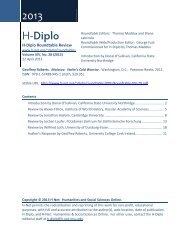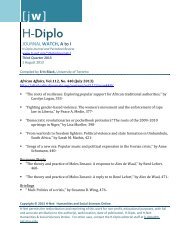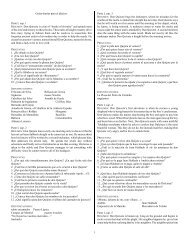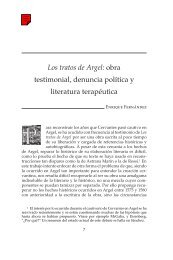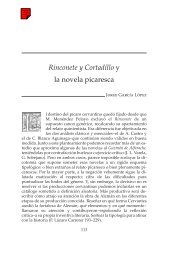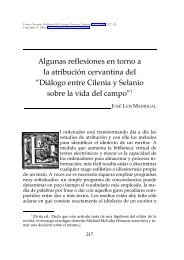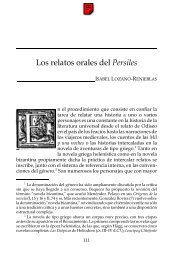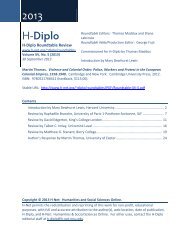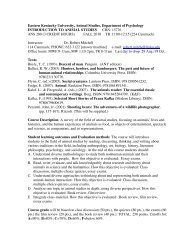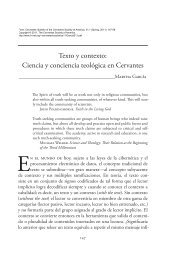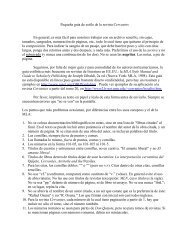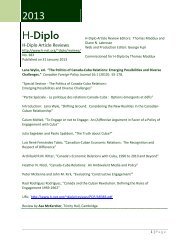The Function of Skepticism in Part I of Don Quijote - H-Net
The Function of Skepticism in Part I of Don Quijote - H-Net
The Function of Skepticism in Part I of Don Quijote - H-Net
Create successful ePaper yourself
Turn your PDF publications into a flip-book with our unique Google optimized e-Paper software.
Volume 30.2 (2010) <strong>The</strong> <strong>Function</strong> <strong>of</strong> <strong>Skepticism</strong><br />
137<br />
with his failed attempt to make a celada, and his attempt to obta<strong>in</strong> better<br />
protection with the yelmo is re<strong>in</strong>forced: he wishes to have the yelmo<br />
because “será bastante para defenderme de alguna pedrada.” <strong>The</strong> fact that<br />
latter on the yelmo not only fails him, but it is actually used to beat him<br />
shows one more time the falsehood <strong>of</strong> his dogmatic beliefs: one cannot<br />
use a bacía to protect one-self from stones thrown to the face.<br />
Several critics have po<strong>in</strong>ted out that the yelmo is one <strong>of</strong> the most<br />
important devices used by Cervantes to give structure to the novel. 23<br />
However, when we consider the issue from the perspective <strong>of</strong> his dogmatism,<br />
we discover that this device does not start with the yelmo per<br />
se: it beg<strong>in</strong>s with <strong>Quijote</strong>’s attempt to make a celada “f<strong>in</strong>ísima” out <strong>of</strong> a<br />
morriόn simple (which is dogmatically obta<strong>in</strong>ed), and it then cont<strong>in</strong>ues<br />
with the yelmo (which is obta<strong>in</strong>ed just as dogmatically). <strong>The</strong> thematic<br />
connection is there because <strong>in</strong> both cases, the protection for his head is<br />
<strong>in</strong>adequate, and it is precisely the <strong>in</strong>adequacy <strong>of</strong> the celada what prompts<br />
him to seek the yelmo.<br />
In fact, the thematic thread beg<strong>in</strong>s even before the ill-fated construction<br />
<strong>of</strong> the celada: Two <strong>of</strong> his possible surnames are “Quijada” or<br />
“Quesada”. <strong>The</strong> name “Quijada” br<strong>in</strong>gs attention to the feature on his<br />
head that will be unprotected the most throughout his adventures: his<br />
ch<strong>in</strong>. <strong>The</strong> name “Quesada” br<strong>in</strong>gs attention to the state <strong>of</strong> his dogmatic<br />
feeble m<strong>in</strong>d, a m<strong>in</strong>d which is made <strong>of</strong> cheese. <strong>The</strong> op<strong>in</strong>ions <strong>of</strong> Frederick<br />
de Armas and Agustín Redondo add strength to this <strong>in</strong>terpretation. <strong>The</strong><br />
latter critic takes <strong>in</strong>to account that “quesada” is similar to cheese, and<br />
then he ma<strong>in</strong>ta<strong>in</strong>s that cheese is a sign <strong>of</strong> <strong>Don</strong> <strong>Quijote</strong>’s madness (1998,<br />
215-6). <strong>The</strong> former critic makes a strong connection between the name<br />
“Quijada” and the ch<strong>in</strong> <strong>of</strong> the emperor Charles V. In both cases the ch<strong>in</strong><br />
is viewed as “a sign <strong>of</strong> determ<strong>in</strong>ation” (2006, 119). Later on de Armas will<br />
also add that “although [the knight] is constantly defeated, his determ<strong>in</strong>ation<br />
[his ch<strong>in</strong>] leads him from one battle to the next” (120). <strong>The</strong>refore,<br />
the ch<strong>in</strong> br<strong>in</strong>gs attention to the knight’s <strong>in</strong>ability to change his m<strong>in</strong>d,<br />
even though he is constantly defeated. In other words, his unprotected ch<strong>in</strong><br />
br<strong>in</strong>gs attention to his dogmatism.<br />
23 See, for example, Michael McGaha (1981), Manuel Durán (1995) and Peter N. Dunn<br />
(1996).



